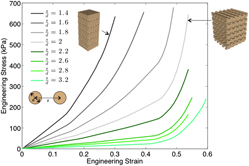Article contents
A mechanical reduced order model for elastomeric 3D printed architectures
Published online by Cambridge University Press: 21 January 2018
Abstract

Direct ink writing of silicone elastomers enables printing with precise control of porosity and mechanical properties of ordered cellular solids, suitable for shock absorption and stress mitigation applications. With the ability to manipulate structure and feedstock stiffness, the design space becomes challenging to parse to obtain a solution producing a desired mechanical response. Here, we derive an analytical design approach for a specific architecture. Results from finite element simulations and quasi-static mechanical tests of two different parallel strand architectures were analyzed to understand the structure-property relationships under uniaxial compression. Combining effective stiffness-density scaling with least squares optimization of the stress responses yielded general response curves parameterized by resin modulus and strand spacing. An analytical expression of these curves serves as a reduced order model, which, when optimized, provides a rapid design capability for filament-based 3D printed structures. As a demonstration, the optimal design of a face-centered tetragonal architecture is computed that satisfies prescribed minimum and maximum load constraints.
- Type
- Invited Articles
- Information
- Journal of Materials Research , Volume 33 , Issue 3: Focus Issue: Architected Materials , 14 February 2018 , pp. 309 - 316
- Copyright
- Copyright © Materials Research Society 2018
Footnotes
This author was an editor of this journal during the review and decision stage. For the JMR policy on review and publication of manuscripts authored by editors, please refer to http://www.mrs.org/editor-manuscripts/.
Contributing Editor: Katia Bertoldi
References
REFERENCES
- 12
- Cited by



